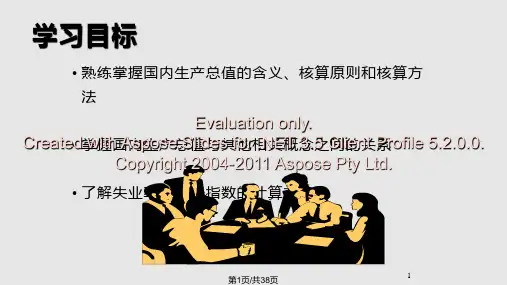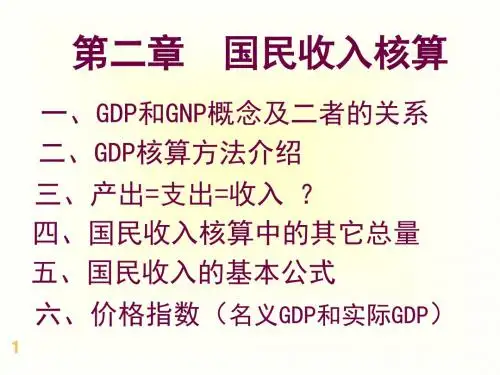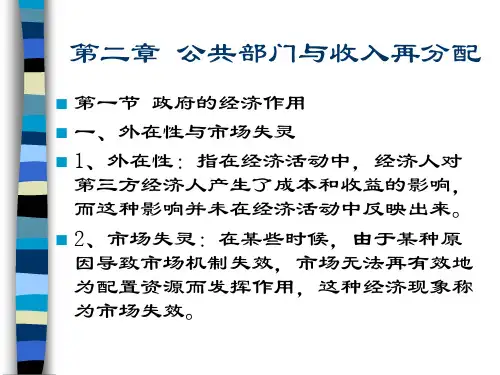宏观经济学课件 第二章
- 格式:pdf
- 大小:423.26 KB
- 文档页数:76











可编辑修改精选全文完整版宏观经济学课件chapter02Macroeconomics, 6e (Blanchard/Johnson)Chapter 2: A Tour of the Book2.1 Multiple Choice Questions1) Fill in the blank for the following: GDP is the value of all ________ produced in a given period.A) final and intermediate goods and services produced by the private sector onlyB) final goods and servicesC) final and intermediate goods and services, plus raw materialsD) all of the aboveE) none of the aboveAnswer: BDiff: 12) When using the income approach to measure GDP, the largest share of GDP generally consists ofA) interest income.B) labor income.C) indirect taxes.D) profits.E) capital income.Answer: BDiff: 13) For this question, assume that 1980 is the base year. Given macroeconomic conditions in the United States over the past three decades, we know thatA) nominal GDP is always smaller than real GDP since 1980.B) real GDP and nominal GDP would be equal for the entire period.C) real GDP is larger than nominal GDP from 2002 to 2008.D) real GDP and nominal GDP were equal in 1980.E) none of the aboveAnswer: DDiff: 24) Suppose nominal GDP increased in a given year. Based on this information, we know with certainty thatA) real output has increased.B) the price level (GDP deflator) has increased.C) real output and the price level (GDP deflator) have both increased.D) either real output or the price level (GDP deflator) have increased.E) real output has increased and the price level has decreased.Answer: DDiff: 25) Use the following information to answer this question. If nominal GDP rises from $100 trillion to $120 trillion, while the GDP deflator rises from 2.0 to 2.2, the percentage change in real GDP is approximately equal toA) -10%.B) 10%.C) 20%.D) 9.1%.E) 0%.Answer: DDiff: 26) Hedonic pricing isA) the way that luxury goods are priced in a market economy.B) the tendency for the inflation rate to rise by greater and greater amounts.C) the tendency for nominal GDP to rise when the price level rises.D) the process of translating nominal GDP into real GDP.E) the process of pricing individual characteristics of a good or service.Answer: EDiff: 17) In a given year, suppose a company spends $100 million on intermediate goods and $200 million on wages, with no other expenses. Also assume that its total sales are $800 million. The value added by this company equalsA) $200 million.B) $300 million.C) $500 million.D) $700 million.E) $800 million.Answer: DDiff: 28) A firm's value added equalsA) its revenue minus all of its costs.B) its revenue minus its wages.C) its revenue minus its wages and profit.D) its revenue minus its cost of intermediate goods.E) none of the aboveAnswer: DDiff: 29) Suppose you are provided with the following data for yourcountry for a particular month: 200 million people are working, 20 million are not working but are looking for work, and 40 million are not working and have given up looking for work. The official unemployment rate for that month isA) 7.7%.B) 9.1%.C) 10%.D) 23%.E) 30%.Answer: BDiff: 110) In the United States, someone is classified as unemployed if he or sheA) does not have a job.B) does not have a job, or else has a job but is looking for a different one while continuing to work.C) does not have a job, has recently looked for work, and is collecting unemployment insurance.D) does not have a job, and is collecting unemployment insurance.E) none of the aboveAnswer: EDiff: 111) An individual is said to be a discouraged worker if he or sheA) is working, but prefers not to work.B) is working part time, but would prefer a full time job.C) is working in jobs she/he is not suited for.D) wants to work, and is actively searching for a job.E) wants to work, but has given up searching for a job.Answer: EDiff: 112) Which of the following tends to occur when the unemployment rate increases?A) a reduction in the labor force participation rateB) a reduction in the number of discouraged workersC) an increase in the number of employed workersD) all of the aboveE) none of the aboveAnswer: ADiff: 113) Labor income's share in an advanced country is likely to beA) 70%.B) 45%.C) 29%.D) 10%.E) none of the aboveAnswer: ADiff: 214) The labor force in the United States is defined asA) the total number of individuals who are employed.B) the sum of the total number of individuals who are employed and the officially unemployed.C) the sum of the total number of individuals who are employed, the officially unemployed, and discouraged workers.D) the total number of individuals who are 16 years old and older, but not retired.E) none of the aboveAnswer: BUse the information provided below to answer the following questions.Suppose a country using the United States' system of calculating official unemployment statistics has 100 million people, of whom 50 million are working age. Of these 50 million, 20 million have jobs. Of the remainder: 10 million are actively searching for jobs; 10 million would like jobs but are not searching; and 10 million do not want jobs at all.15) Refer to the information above. The labor force isA) 20 million.B) 40 million.C) 60 million.D) 80 million.E) 100 million.Answer: CDiff: 216) Refer to the information above. The labor force participation rate isA) .2.B) .3.C) .4.D) .6.E) .8.Answer: DDiff: 217) Refer to the information above. The official unemployment rate isA) .1.B) .2.D) .4.E) .66.Answer: CDiff: 218) The GDP deflator provides a measure of which of the following?A) the ratio of GDP to the size of the populationB) the ratio of GDP to the number of workers employedC) the ratio of nominal GDP to real GDPD) the price of a typical consumer's basket of goodsE) real GDP divided by the aggregate price levelAnswer: CDiff: 119) Which of the following calculations will yield the correct measure of real GDP?A) divide nominal GDP by the consumer price indexB) divide the GDP deflator by the consumer price indexC) multiply nominal GDP by the consumer price indexD) multiply nominal GDP by the GDP deflatorE) none of the aboveAnswer: EDiff: 220) The prices for which of the following goods are included in both the GDP deflator and the consumer price index?A) goods bought by householdsB) goods bought by firmsC) good bought by governmentsD) goods bought by foreign households (i.e., exports)E) all of the aboveAnswer: ADiff: 221) Suppose we switch the base year from 2000 to 2008. This change in the base year will causeA) nominal GDP in every year to increase.B) nominal GDP in every year to decrease.C) both nominal and real GDP in every year to decrease.D) real GDP in every year to decrease.E) none of the aboveAnswer: EDiff: 222) Pure inflation occurs whenA) nominal wages rise faster than all prices.B) all prices rise faster than nominal wages.C) all prices and nominal wages rise by the same percentage.D) the GDP deflator and Consumer Price Index rise by the same percentage.E) none of the aboveAnswer: CDiff: 223) One of the reasons macroeconomists have concerns about inflation is that inflation causesA) real GDP to rise.B) nominal GDP to fall.C) wages to rise as fast as prices.D) real GDP to exceed nominal GDP.E) none of the aboveAnswer: EDiff: 124) Changes in GDP in the short run are caused primarily byA) demand factors.B) supply factors.C) technology.D) capital accumulation.E) all of the aboveAnswer: ADiff: 225) Changes in GDP in the medium run are determined primarily byA) demand factors.B) supply factors.C) monetary policy.D) all of the aboveAnswer: BDiff: 226) Changes in GDP in the long run are determined primarily byA) monetary policy.B) fiscal policy.C) demand.D) all of the aboveE) none of the aboveAnswer: EDiff: 227) Which of the following prices will be used when calculating the rate of growth of real GDP between the year's 2005 and 2006 using the chain method?A) prices in the base year (2002)B) prices in 2005C) prices in 2006D) the average of prices in 2005 and 2006E) prices in 2005, 2006, and in 2002 (the base year)Answer: DDiff: 228) Which of the following factors is NOT believed to affect output in the long run?A) technologyB) monetary policyC) the size of the labor forceD) the capital stockAnswer: BDiff: 129) The Okun's law shows the relationship betweenA) inflation and unemployment rate.B) output growth and unemployment.C) inflation and output growth.D) output growth and money supply.Answer: BDiff: 230) The Phillips curve describes the relationship betweenA) output growth and unemployment.B) inflation and output growth.C) output growth and money supply.D) inflation and unemployment .Answer: DDiff: 231) Prices for which of the following are included in the GDP deflator, but not included in the Consumer Price Index?A) firms' purchases of new equipmentB) intermediate goods and servicesC) consumption of goodsD) consumption of servicesAnswer: ADiff: 132) Macroeconomists are concerned about changes in the unemployment rate because changes in the unemployment rate provide information aboutA) the state of the economy.B) the welfare of those who are unemployed.C) none of the aboveD) both A and BAnswer: DDiff: 133) Based on the notation presented in Chapter 2, which of the following expressions represents nominal GDP?A) Y tB) P t Y tC) Y t/P tD) $Y t/P tAnswer: BDiff: 134) Deflation generally occurs when which of the following occurs?A) the consumer price index is greater than the GDP deflatorB) the consumer price index decreasesC) the rate of inflation falls, for example, from 4% to 2%D) nominal GDP does not changeAnswer: BDiff: 135) During the mid-1980s, we observed a significantreduction in oil prices. In the United States, we would expect that this reduction in oil prices would causeA) a larger reduction in the CPI compared to the GDP deflator.B) an equal reduction in the CPI and GDP deflator.C) a larger reduction in the GDP deflator compared to the CPI.D) no change in the CPI and a reduction in the GDP deflator.Answer: ADiff: 236) Suppose nominal GDP in 2009 does not change (compared its previous level in 2008). Given this information, we know with certainty thatA) real GDP increased during 2009.B) the GDP deflator increased during 2009.C) both the GDP deflator and real GDP fell during 2009.D) more information is needed to answer this question.Answer: DDiff: 237) During the late 1990s, Japan experienced reductions in the GDP deflator. Given this information, we know with certainty thatA) real GDP fell during these periods.B) real GDP did not change during these periods.C) the overall price level in Japan decreased during these periods.D) both real GDP and the overall price level decreased during these periods. Answer: CDiff: 238) Hedonic pricing is used toA) convert nominal values to real values.B) calculate the difference between nominal GDP and real GDP.C) measure the rate of change in real GDP.D) obtain chain-weight indexes.E) none of the aboveAnswer: EDiff: 139) GDP in current dollars is equivalent to which of the following?A) real GDPB) GDP in terms of goodsC) GDP in 2000 dollarsD) GDP in constant dollarsE) none of the aboveAnswer: EDiff: 140) Which of the following does NOT represent real GDP?A) GDP in current dollarsB) GDP in terms of goodsC) GDP in base year dollarsD) GDP in constant dollarsAnswer: ADiff: 141) which of the following represents real GDP?A) GDP in constant dollarsB) GDP in terms of goodsC) GDP in base year dollarsD) all of aboveAnswer: ADiff: 142) According to convention, a recession is referred to if an economy goes throughA) at least two consecutive quarters of negative growthB) at least three consecutive quarters of negative growthC) at least four quarters of negative growthD) at least two consecutive months of negative growthAnswer: ADiff: 143) Based on the notation presented in Chapter 2, which of the following expressions represents real GDP?A) Y tB) P t Y tC) Y t/P tD) $Y t/P tAnswer: ADiff: 144) Measures of aggregate output have been published on a regular basis in the United States sinceA) 1947.B) 1933.C) 1917.D) 1946.Answer: ADiff: 145) Which of the following about capital income is NOT correct?A) it refers to a firm's revenue.B) it is also called profit income.C) it goes to the firms.D) it accounts for less than 35% of income in advancedcountries.Answer: ADiff: 146) Which of the following about the Phillips curve is NOT correct?A) It shows the relation between GDP growth and unemployment.B) It has been redefined as a relation between the change in the rate of inflation and the unemployment rate.C) It was first explored by A. W. Phillips.D) The curve is downward sloping.Answer: ADiff: 12.2 Essay Questions1) Explain the three ways GDP can be measured.Answer: GDP can be measured three ways. First, GDP represents the market value of the final goods and services produced in the economy during a given period. This would be obtained by adding C, I, G, and NX. Second, GDP is the sum of the value added by firms. The value added for a firm equals the value of the production (at that stage of the production process) minus the value of the intermediate goods (excluding labor services). The final value of aggregate output can be calculated by either summing the value of all final goods and services OR by summing the value added of all goods and services at each stage of production. And finally, GDP is also the sum of all incomes earned in a given period.2) First, define nominal GDP and real GDP. Second, is it possible for nominal GDP in a year to be less than real GDP in the same year? Explain.Answer: Nominal GDP represents the value of goods and services produced using current prices. Real GDP measures the value of the same goods and services using some base year prices. It is possible for nominal GDP to be less than real GDP in a given year. Given the definitions of the two variables, this will occur if prices in that year are simply less than prices in the base year. If, for example, the base year is 2002, it will generally be the case that nominal GDP will be less than real GDP for those years prior to 2002 given that prices have generally risen in all years. 3) Explain whether it is possible for nominal GDP to increase and real GDP to decrease in the same period.Answer: Nominal GDP can rise because either the price level is rising or the real quantity of goods and services produced has increased. Nominal GDP can increase while real GDP falls if the increase in the aggregate price level is larger (in a proportionate sense) than the drop in real economic activity.4) Explain the difference between the unemployment rate and the participation rate.Answer: The unemployment rate is the percentage of the labor force (those employed and unemployed) that is unemployed. The participation rate is the percentage of the working age population that is in the labor force.5) Explain how the existence of discouraged workers alters the extent to which the official unemployment provides an accurate measure of the use of labor resources.Answer: Discouraged workers are those individuals who have decided to stop searching for employment because they have become "discouraged" about employment opportunities. At some point, these individuals will no longer be considered as part of the labor force. The existence of discouraged workers willcause the official unemployment rate to provide an under-estimate of the underutilization of labor.6) Briefly explain why the reported official unemployment rate in Spain in 1994 may have provided an over-estimate of unemployment in Spain.Answer: The relatively high unemployment rate in Spain is partly the result of a relatively large underground economy. The underground economy is that part of the economy not measured in official statistics. After taking into account those individuals who are "employed" in the underground economy, the unemployment rate in Spain would have been lower (but still relatively high).7) What are the social and economic implications of unemployment? Explain.Answer: Economic implications: signal of economic activity and measure of the utilization of labor. Social implications: the emotional and psychological suffering that occurs as a result of being unemployed.8) Explain what factors cause changes in output in: (1) the short run; (2) medium run; and (3) long run.Answer: In the short run, demand factors primarily cause changes in output. In the medium run, factors such as the technology, amount of capital, and the skill and size of the labor force (supply factors) affect output. And in the long run, the education system, saving rate, and role of government affect economic activity.9) Will the CPI and GDP deflator always move together? Explain.Answer: No they will not. Some of the goods included in the GDP deflator (some investment goods) are not included in theCPI. Some of the goods included in the CPI (foreign goods) are not included in the GDP deflator.10) Explain how inflation can lead to distortions.Answer: First, not all prices and wages adjust automatically when inflation occurs. Second, variations in relative prices (which occur when there is not pure inflation) can lead to uncertainty. Inflation can also lead to distortions if the tax system is not adjusted when inflation occurs (e.g. nominal income tax brackets).11) Explain why economists care about inflation.Answer: Inflation will cause relative prices to change. It will also cause changes in the distribution of income. Inflation will lead to other distortions such as tax distortions and uncertainty.12) Explain Okun's Law.Answer: It shows the relationship between GDP growth and unemployment rate. If output growth is high, unemployment will decrease.13) Explain the Phillips curve.Answer: It shows the negative relationship between inflation rate and unemployment rate. After 1970s, it was redefined as the relationship between the change in the rate of inflation and the unemployment rate.14) Explain why the Phillips curve on average is downward sloping.Answer: When unemployment becomes very low, the economy is likely to overheat and this will lead to upward pressure on inflation.15) Explain why economists care about unemployment.Answer: First, they care about unemployment because of its direct effect on the welfare of the unemployed. Unemployment is often associated with financial and psychological suffering.Second, they care about unemployment because it provides a signal that the economy may not be using some of its resources efficiently.16) Can an economy maintain high output growth, low unemployment, and low inflation at the the same time? Explain.Answer: It would be very hard to achieve the three objectives at the same time. High output growth leads to low unemployment, which is likely to put pressure on inflation.。